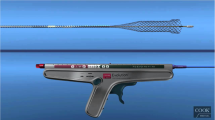Abstract
Background
We evaluated the clinical efficacy and technical feasibility of the percutaneously inserted self-expandable nitinol stent (Zilver stent) for palliation of malignant biliary obstruction.
Methods
Seventeen patients with malignant tumors involving the intra- or extrahepatic bile duct who presented with obstructive jaundice underwent percutaneous insertion of a self-expandable nitinol stent. We retrospectively reviewed the hospital records of patients and evaluated the technical feasibility on stent placement, complications, patient survival, and duration of stent patency.
Results
Percutaneous biliary stenting with 27 Zilver stents was performed in 17 patients with malignant biliary obstruction. Technical success was 95%. Malposition of the stent was encountered in one patient. Minor technical problems were encountered in two patients: the introducer tip was broken during stent insertion, so endoscopic removal was done. Mean follow-up period for the 17 patients was 182 days (range 29–485 days): nine patients died of progressive disease at a mean follow-up of 151 days (range 61–371days) after stent insertion and eight patients remained alive at the final follow-up of 216 days (range 29–485 days). The median survival period for all patients was 277 days. The stent occlusion rate was 26% and the mean patency period was 280 days. In five patients, seven stents were obstructed by tumor ingrowth and overgrowth. Stent patency rates were 100%, 100%, 75%, 61%, and 41% at 1, 2, 3, 6, and 12 months, respectively. A late complication, erosive bleeding of the hepatic artery by the stent, developed in one patient.
Conclusion
Percutaneous biliary stenting using the nitinol stent is technically feasible and safe and clinically efficacious treatment for malignant biliary obstruction, even with a minor technical problem during stent insertion.





Similar content being viewed by others
References
Carrasco CH, Wallace S, Charnsangavej C. Expandable biliary endoprosthesis: an experimental study. AJR 1985;145:1279–1281
Davids PHP, Groen AK, Rauws EA, et al. Randomized trial of self-expanding metal stents versus polyethylene stents for distal malignant biliary obstruction. Lancet 1992;340:1488–1492
Adam A, Chettly N, Roddie M, et al. Self-expanding stainless steel endoprostheses for treatment of malignant bile duct obstruction. AJR 1991;156:321–325
Coons HG. Self-expanding stainless steel biliary stents. Radiology 1989;170:979–983
Gillams A, Dick R, Dooley JS, et al. Self-expandable stainless steel braided endoprosthesis for biliary strictures. Radiology 1990;174:137–140
Irving JD, Adam A, Dick R, et al. Gianturco expandable metallic biliary stents: results of a European clinical trial. Radiology 1989;172:321–326
Lammer JS, Klein GE, Kleinert R, et al. Obstructive jaundice: use of expandable metal endoprosthesis for biliary drainage. Radiology 1990;177:789–792
Lameris JS, Stocker J, Nijs HG. Malignant biliary obstruction: percutaneous use of self-expandable stents. Radiology 1991;179:703–707
Yoshioka T, Sakaguchi H, Yoshimura H. Expandable metallic biliary endoprostheses: preliminary clinical evaluation. Radiology 1990;177:253–257
Bezzi M, Orsi F, Salvatori FM, et al. Self-expandable nitinol stent for the management of biliary obstruction: long-term clinical results. J Vasc Interv Radiol 1994;5:287–293
Rossi P, Bezzi M, Rossi M. Metallic stents in malignant biliary obstruction: results of a multicenter European study of 240 patients. J Vasc Interv Radiol 1994;5:279–285
Mathieson JR, McLoughlin RF, Cooperberg PL. Malignant obstruction of the common bile duct: long-term results of Gianturco-Rosch metal stents used as initial treatment. Radiology 1994;192:663–667
Watkinson A. Hepatobiliary intervention. In: Watkinson A, Adam A (eds). Interventional radiology, a practical guide. Oxford: Oxon Radcliffe Medical Press, 1996:pp 59
Gordon RL, Ring EJ, LaBerge JM, Doherty MM. Malignant biliary obstruction: treatment with expandable metallic stents: follow-up of 50 consecutive patients. Radiology 1992;182:697–701
Inal M, Akgul E, Aksungur E, Seydaoglu G. Percutaneous placement of biliary metallic stents in patients with malignant hilar obstruction: unilobar versus bilobar drainage. J Vasc Interv Radiol 2003;14:1409–1416
Lee MJ, Dawson SL, Mueller PR, et al. Palliation of malignant bile duct obstruction with metallic biliary endoprostheses: technique, results, and complications. J Vasc Interv Radiol 1992;3:665–671
Stoker J, Lameris JS, van Blankestein M. Percutaneous metallic self-expandable endoprostheses in malignant hilar biliary obstruction. Gastrointest Endosc 1993;39:43–49
Brountzos EN, Petropoulos E, Kelekis NL. Malignant biliary obstruction: management with percutaneous metallic stent placement. Hepatogastroenterology 1999;46:2764–2771
Oikarinen H, Leinonen S, Karttunen A. Patency and complications of percutaneously inserted metallic stents in malignant biliary obstruction. J Vasc Interv Radiol 1999;10:1387–1393
Han YM, Hwang SB, Lee ST, et al. Polyurethane-covered self-expandable nitinol stent for malignant biliary obstruction: preliminary results. Cardiovasc Interv Radiol 2002;25:381–387
Han YM, Jin GY, Lee SO, Kwak HS, Chung GH. Flared polyurethane-covered self-expandable nitinol stent for malignant biliary obstruction. J Vasc Interv Radiol 2003;14:1291–1301
Varadarajulu S, Tutuian R, Gostout C, et al. Efficacy of the Za self-expandable metal stent for palliation of malignant biliary obstruction. J Clin Gastroenterol 2004;38:77–80
Acknowledgment
This study was supported by a 2003 scientific research grant from Inje University.
Author information
Authors and Affiliations
Corresponding author
Additional information
An erratum to this article can be found online at http://dx.doi.org/10.1007/s00261-011-9714-0
Rights and permissions
About this article
Cite this article
Han, Y.H., Kim, MY., Kim, S.Y. et al. Percutaneous insertion of Zilver stent in malignant biliary obstruction. Abdom Imaging 31, 433–438 (2006). https://doi.org/10.1007/s00261-005-8017-8
Received:
Accepted:
Published:
Issue Date:
DOI: https://doi.org/10.1007/s00261-005-8017-8




